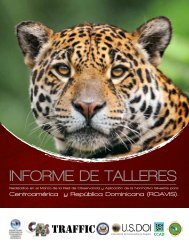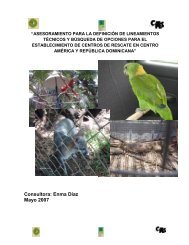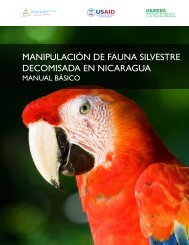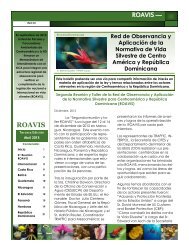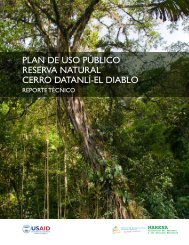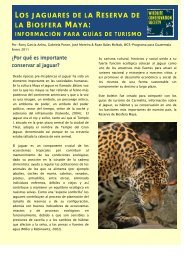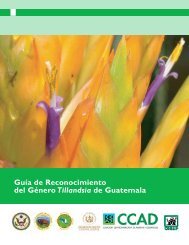Updated Listings of Fauna and Flora Species - caftadr-environment ...
Updated Listings of Fauna and Flora Species - caftadr-environment ...
Updated Listings of Fauna and Flora Species - caftadr-environment ...
- No tags were found...
You also want an ePaper? Increase the reach of your titles
YUMPU automatically turns print PDFs into web optimized ePapers that Google loves.
UPDATED LISTINGS OF FLORA AND FAUNA SPECIESINCLUDED IN THE CITES APPENDICES DISTRIBUTED IN CENTRAL AMERICA AND DOMINICAN REPUBLICWhat is CITES?CITES is an international agreement between Governments. It aims to ensure that international tradein specimens <strong>of</strong> wild animals <strong>and</strong> plants does not constitute a threat to their survival. It is estimatedthat annual international wildlife trade amounts to billions <strong>of</strong> dollars <strong>and</strong> affects hundreds <strong>of</strong> millions <strong>of</strong>specimens <strong>of</strong> wild animals <strong>and</strong> plants.Considering that trade in wild plants goes beyond borders between countries, regulations require internationalcooperation to protect certain species from overexploitation. The CITES was conceived within theframework <strong>of</strong> that spirit <strong>of</strong> cooperation. Today, it <strong>of</strong>fers varying degrees <strong>of</strong> protection to more than 30,000species <strong>of</strong> animals <strong>and</strong> plants, marketed either as living or dead specimens, or as parts or derivatives.How does CITES work? (Modified from: www.cites.org)The CITES subjects the international trade in specimens <strong>of</strong> some species to certain controls. Every import,export, re-export or introduction <strong>of</strong> a large number <strong>of</strong> marine species covered by the Convention must beauthorized following a system <strong>of</strong> permit or certificate granting.Each party to the Convention must designate one or more administrative authorities responsible for managingthe system for the granting <strong>of</strong> permits or certificates, <strong>and</strong> one or more Scientific Authorities to adviseon the impact <strong>of</strong> trade <strong>of</strong> the wild species (www.cites.org).<strong>Species</strong> included in the CITES appendices may be imported or exported (or re-exported)only if the appropriatedocument that accompanies the specimen is obtained <strong>and</strong> presented at customs in a port <strong>of</strong> entryor exit. CITES guidelines are established in the Convention Text (www.cites.org/texto). Its- compliance isalso bound by the provisions <strong>of</strong> a general legal framework that should be incorporated into specific nationallaws to ensure their observance, <strong>and</strong> which must not be <strong>of</strong> lesser requirement than the Convention. However,it may vary from one country to another especially when national laws have adopted more stringentmeasures, therefore it is advisable to consult the legislation adopted by each signatory party.The Conference <strong>of</strong> the Parties (COP) is the supreme decision-making organ <strong>of</strong> the Convention <strong>and</strong>is composed <strong>of</strong> all the member countries. The ninth Conference adopted resolution Conf. 9.24 (Rev.(CdP13), which sets forth biological <strong>and</strong> trade criteria to determine whether a species should be includedin Appendix I or II. At each COP meeting, the Parties submit proposals based on those criteria to amendthese two appendices.The first Conference <strong>of</strong> the Parties was held in Bern, Switzerl<strong>and</strong> in November 1976, <strong>and</strong> the first list <strong>of</strong>Appendix I <strong>and</strong> II species was adopted during this event. Many <strong>of</strong> these species were included more withthe intention <strong>of</strong> conservation than because they were threatened by international trade. Therefore, in thefollowing Conferences <strong>of</strong> the Parties (14 have been held to date), many <strong>of</strong> these species were transferredfrom Appendix I to Appendix II <strong>and</strong> later removed from the lists.Some 5,000 species <strong>of</strong> animals <strong>and</strong> 28,000 species <strong>of</strong> plants are covered by the CITES against over-exploitationthrough international trade. The species are grouped in appendices according to the degree <strong>of</strong>threat imposed by international trade. Sometimes entire groups (families or genera) are included, such asprimates, whales, sea turtles, felines, cacti, <strong>and</strong> orchids. Other cases include only one subspecies, or a populationgeographically isolated <strong>of</strong> a species (population, subspecies, or variety <strong>of</strong> a country).The species covered by CITES are included in three appendices (www.cites.org/Appendices), dependingon the degree <strong>of</strong> protection they need: Appendix I, Appendix II, <strong>and</strong> Appendix III.Appendix I: Appendix I includes all species threatened by extinction. Trade in specimens <strong>of</strong> these species isprohibited <strong>and</strong> authorized only under exceptional circumstances.Appendix II: In Appendix II are included species not necessarily endarngered by extinction but its trademust be controlled in order to avoid utilization incompatible with their survival. <strong>Species</strong> similar in appearanceto those already in this list are also included.Appendix III: This Appendix includes species protected in at least one country that has requested assistancefrom other parties in the CITES to control their trade.Changes in Appendix III are made differently than those made to Appendices I <strong>and</strong> II, since each partymay make unilateral amendments to it, so that the inclusion or exclusion <strong>of</strong> species can be at any time,while amendments to Appendices I <strong>and</strong> II should be adopted by the Conference <strong>of</strong> the Parties.1011



